Dinosaur dig
Researchers uncover the fossil bones of a new species of long-necked, plant-eating dinosaur.
By Sid Perkins
It was hot and dry when I spent the Fourth of July digging for fossils on the 5E Ranch north of Billings, Mont.
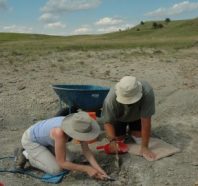 |
|
At a dinosaur dig in central Montana, workers use a small air hammer to break apart rocks.
|
| Sid Perkins |
This sort of weather isn’t unusual in central Montana. Some parts of the state are nearly a mile above sea level and get only 10 inches of rain each year.
But about 150 million years ago when dinosaurs ruled Earth, the land that is now the 5E Ranch sat near sea level. Part of it was a wetland.
The fossils that a few dozen other people and I dug up will help scientists understand more about what this ancient environment was like and what types of animals and plants lived there.
Treasure hunt
Digging for fossils is like a big treasure hunt. Sometimes, you don’t find much. Sometimes, you strike fossil gold.
At the 5E Ranch, paleontologists recently identified a new species of dinosaur. It was a large, long-necked creature that ate plants—a type of dinosaur called a sauropod.
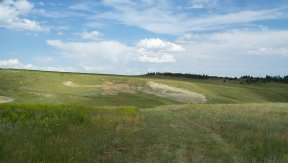 |
|
Paleontologists have unearthed fossils of a new species of sauropod on this hillside on the 5E Ranch in Montana.
|
| Colleen Dundon |
The events that led to the discovery began in 1985, when rancher Dave Hein found some pieces of fossilized bone lying on a hillside. Over the next 18 years, he found many more bone chips, including a large fragment of a rib, at the same place.
“We kept them in a coffee can at the ranch house,” Hein says.
Then, in 2003, Hein and his son used earthmoving equipment to remove soil layers and expose the rock. After they uncovered some fossilized neck bones and ribs, they called local paleontologists to get expert advice. Eventually, Hein connected with Nate Murphy, research director of the Judith River Dinosaur Institute in Malta, Mont. Murphy decided to make a visit to the 5E ranch.
In 2004, Murphy and his team unearthed more bones at the site. They found four neck vertebrae, a portion of a leg bone, and nearly a dozen ribs.
Hein and Murphy nicknamed the dinosaur “Ralph”—in honor of a relative of Hein who had lived near the discovery site almost a century ago.
A surprising skull
Last year, the researchers found more of Ralph’s bones, including seven neck vertebrae and, surprisingly, his skull.
“Sauropod skulls are very rare,” Murphy says.
Even though sauropods included some of the largest creatures ever to walk on land, their heads were small and their skulls were delicate. Only 20 or so sauropod skulls have ever been found. Most of them are poorly preserved or were flattened when they were buried by sediments.
Ralph’s skull, on the other hand, is almost perfectly preserved. Many of the bones in the skull are only 1.5 millimeters thick. That’s thinner than a penny!
“You’d think that he’d have blown his head apart if he sneezed,” Murphy says.
Ralph’s snout was longer than the snouts of some sauropod species and shorter than those of other species. This suggests that members of his species were either ancestors of or close cousins to two known groups of sauropods. One group of species, called brachiosaurs, had relatively long snouts. The other group, which had short snouts, are called camarasaurs.
Wetland remains
The 2006 bone search wasn’t as productive as earlier ones. It revealed only a 20-centimeter-long fragment of one of Ralph’s ribs.
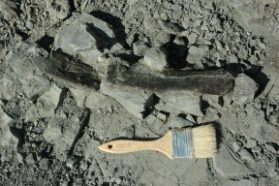 |
|
Participants in a Montana dinosaur dig unearthed a 20-centimeter-long fragment of a fossil rib from a new species of sauropod.
|
| Sid Perkins |
However, some paleontologists focused their hunt on other fossils, such as plants and small animals, which could provide scientists with information about the environment in which Ralph lived.
In the same layer of rock that held Ralph’s bones, members of the dig team found many fossils of plants that resembled reeds, a type of plant that lives in wetlands and on the banks of streams today.
In rocks of the same age at a dig site a few miles away, geologist Cris E. Merta found many fossils, including petrified wood and fragments of freshwater clamshells, turtle shells, alligator vertebrae, and even a crocodile tooth.
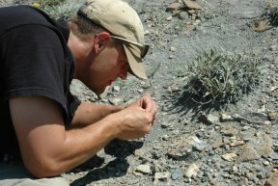 |
|
Geologist Cris Merta examines a tiny fossil fragment.
|
| Sid Perkins |
Together, these fossils suggest that this area was once a forest-lined river or an estuary, Merta says.
More fragments
When this year’s excavations at the Ralph site slowed down, several members of the dig team wandered the nearby hillsides to look for more fossils. About 150 meters north of where Ralph had been found, they discovered several bone fragments.
They dug into the hillside and uncovered a few tail vertebrae and fragments of a tail spike of a stegosaur. The next day, they unearthed more tail vertebrae and some leg bones.
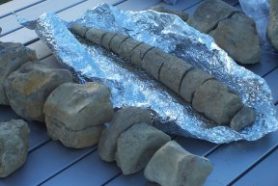 |
|
Tail vertebrae and fragments of a tail spike from a stegosaur found in Montana.
|
| Colleen Dundon |
Because portions of the tail vertebrae weren’t joined as they would be in an adult stegosaur, the bones probably belonged to a young animal, says Susannah Maidment. She’s a paleontologist and stegosaur expert at the University of Cambridge in England.
Certain features of these fossils suggest that they belonged to a Hesperosaurus. That’s an exciting find, Maidment says. Only four other specimens of this creature have ever been found.
Future digging
The team took many of the newly unearthed stegosaur bones back to the lab for detailed analysis. The leg bones that couldn’t be fully excavated this year were left in the ground for next year’s dig team.
To protect those remaining fossils from Montana’s harsh winter weather and from the sharp hooves of cows grazing in the area, the team wrapped the bones in a burlap-and-plaster coating called a field jacket.
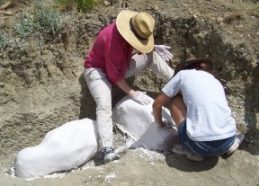 |
|
Workers prepare a burlap-and-plaster coating for a large leg bone still in the ground. At the left is a wrapped bone that’s ready to be loaded onto a truck and shipped to a lab.
|
| Colleen Dundon |
Next year, the treasure-hunting paleontologists will spend at least 2 weeks at the 5E Ranch. They’ll excavate the stegosaur bones that were left behind. They may even unearth additional fossils. Who knows what they’ll find?
In the meantime, Murphy and his coworkers will describe Ralph in a scientific article to be published this fall. When the article is published, Ralph will have a nifty new scientific name to go along with his nickname.
Going Deeper:







